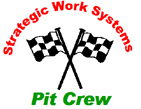“You mean we’re going to have to work on the equipment before it breaks down?”
“What a novel idea,” you say. Believe it or not, that’s what an experienced mechanic said after he heard about a company’s new approach for preventive, proactive, planned maintenance. And his statement really points to the crux of one of the biggest challenges we face when moving from a reactive maintenance work culture to one that emphasizes equipment and process reliability. In many cases, we are challenging the maintenance mindsets of many people at all levels in the organization. So how do you go about changing the work culture? Here are a few ideas based on some significant culture changes we have seen.
The core concept that works for maintenance and manufacturing in North America is to focus on results and change the culture along the way. One of the books that has served as a guide is entitled The Breakthrough Strategy (Robert Schaffer; Harper Business, 1988). It is not a new book or one that addresses maintenance and reliability. But the approaches Mr. Schaffer describes are continually validated in many other writings and by other researchers and authors. Here are the key points of the Breakthrough Strategy as applied to maintenance and manufacturing improvement:
- Top management must orchestrate the architecture for change. Lead the way! Establish the context and the challenge. Set increasingly tough demands to meet the needs of the business and the needs of the people. Test the new directions through strategic projects. Make technology support the desired improvements, rather than be a slave of technology. Orchestrate the total improvement process. Don’t just make pronouncements then back away. Get involved. Listen and pay attention throughout.
- Identify “zest factors” to help accelerate the new ideas. Is there a true sense of urgency? A challenge to meet? Is there an opportunity for clear and near success? Is there an opportunity to increase pride in the workplace or in workmanship? Is there an underlying fear of failure? Can the change be exciting, novel, like a game? Are there a few who would enjoy experimenting while ignoring the red tape? Don’t expect people to get engaged with an idea just because top management espouses it. Determine what will truly engage others in the improvement process.
- Go for results. Immediate successes are essential if people are to increase their confidence and expand their vision of what is possible. Through successful accomplishment of a tangible goal you can learn to function in new and better ways. Wow! Nothing speaks louder than actions and results! Look for opportunities to make equipment run better, last longer, require less “tinkering and tending,” and ways to make peoples’ work easier.
- Form a “steering group” to lead the improvements by focusing on a common goal in a collaborative manner. In union plants, be sure to use a joint union/management steering group of formal and informal leaders.
- Design a “breakthrough” project or pilot activity. Develop a plan to achieve results in a short period of time including. Keep in mind the “zest factors” and “go for results.” Don’t forget these key points when selecting a project or activity:
- Urgent and compelling goals
- Short-term, first step sub goals (quick, sustainable hits)
- Measurable, bottom–line results
- Ready, willing, and able people
- Achievable with available resources & authority
- Breakthrough project leaders with accountability
- Develop performance capability to support the “breakthrough project.” Individual accountability, clear-cut decision making, written work plans and progress reviews, structured involvement, demonstration and testing of innovative approaches, frequent reinforcement and rewards. Honestly provide resources and support for the breakthrough project or pilot activity.
- Form a “breakthrough project team.” People who have the skills and knowledge to work together “outside the box” are likely to exceed your expectations. The “natural work group” and their support resources will develop a sense of ownership and pride that is hard to develop any other way. But be sure to define the parameters they must work within. Select people who can become teachers, coaches, or role models of the new way. Then get out of their way!
- Take action. Put the “breakthrough project” plan into motion. Avoid getting stuck in the plan–to–plan loop and never quite getting around to action.
- Leverage the key learnings from the “breakthrough projects” to expand into other related areas and institutionalize the new ideas. Showcase the new results, the new behaviors, in your business, in your facilities, with your employees. Indisputable proof goes a long way to changing behaviors!
In the past seven years, many Total Productive Maintenance/Manufacturing (TPM) culture changes have knowingly—and unknowingly—followed these steps to achieve significant results and change the way the organization thinks about maintenance and reliability. It is rewarding to see what can truly happen when the talents of the entire organization are tapped in the “breakthrough strategy.” Changing the “work culture” means changing the individual and collective behaviors of people on the job. Go for results in ways that change behaviors along the way.
© 1997
Robert M. Williamson
Strategic Work Systems, Inc.
Columbus, NC 28722
[email protected]
![]() Download a PDF of this article by clicking here CultureArticle
Download a PDF of this article by clicking here CultureArticle
